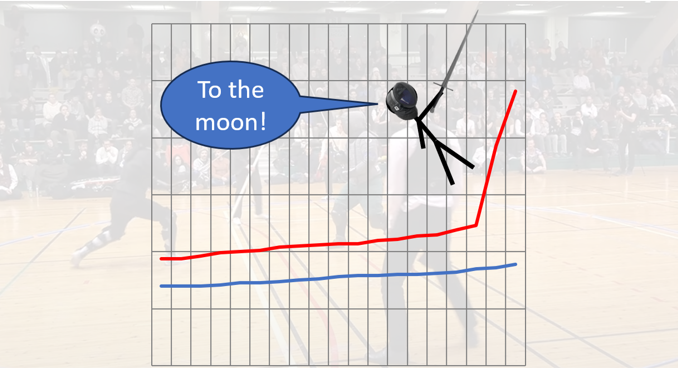
This article uses the PB25 method to calculate a tournament’s overall rating based on the HEMA Rating of all participants. If you want to know how it works, check out On Rating HEMA Tournaments.
A year ago I published Trends In Quality of Competition in HEMA, and the major conclusions were that the gap between European and North American HEMA tournaments had narrowed dramatically post-COIVD.
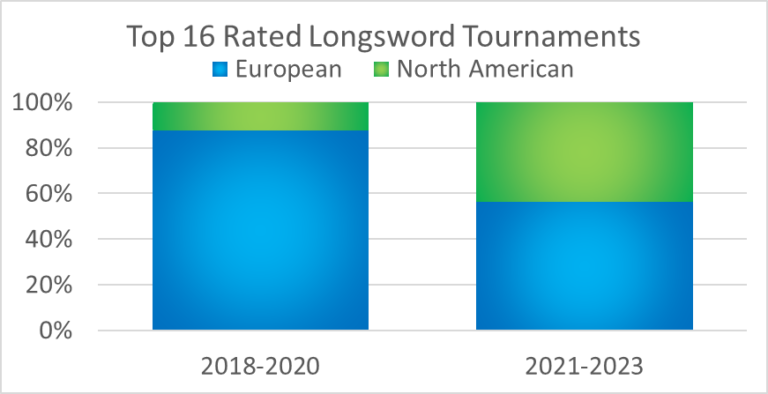
This was a product of the growth of much stronger regional tournaments in North America, and also the lack of large super-tournaments in Europe. And now looking back with a full 12 months of additional information, we can ask if this was an aberration or a sign of things to come.

There is some slight clawback of European dominance, but overall North America still looks much stronger than it did before Covid.
Tournament Size
I didn’t talk about tournament size in the last article, because tournament size doesn’t necessarily correlate to how difficult the tournament is. (Though having a deeper field does make a tournament harder. Normalizing between the depth of talent is what the PB25 indicator is meant to do, as explained in On Rating HEMA Tournaments.) But the change in size from pre-covid to post-covid is an interesting phenomenon.
Pre-covid you see a general trend to North American tournaments being larger than their European counterparts, even if they aren’t as competitive. If we look at the sizes of pre-Covid longsword tournaments with 70 or more competitors:

This is noticeable, but the sizes of large tournaments in North America and Europe are in the same ballpark. But if we made the same plot for post-Covid tournaments? The following is a list of the longsword tournaments that are bigger than the biggest tournament between 2018-2020.
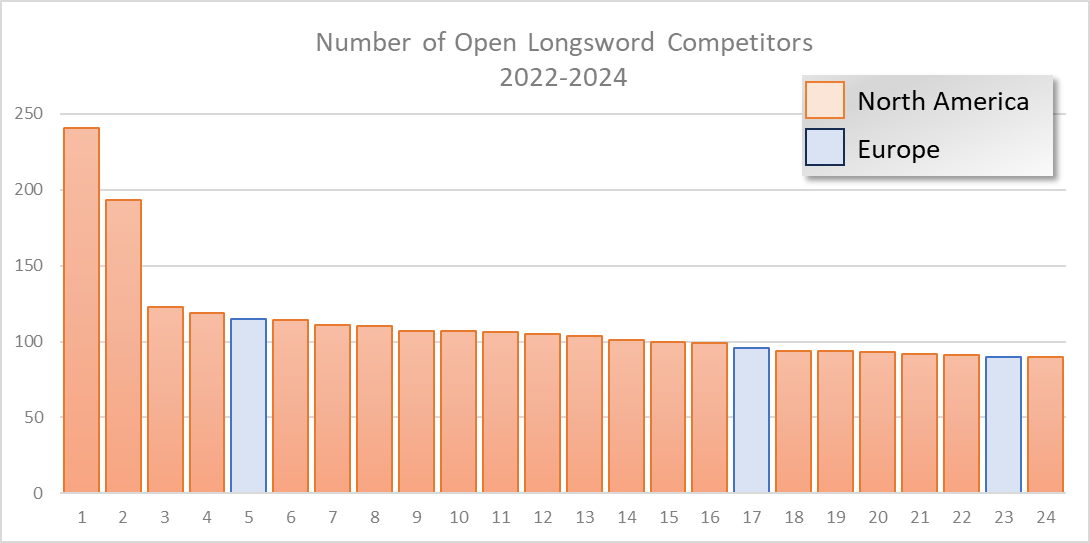
Not only are there 24 events bigger than the biggest event in the 2018-2020 period, the distribution is overwhelmingly skewing North American. So while in 2019 you’d expect to see the biggest tournament in the world fall short of 90 entries, in 2024 you can expect to see 7 tournaments a year exceed that number. Crazy!
Note: The size of HEMA events is also dictated by the registration cap the organizer puts on. So when evaluating tournament size we have to consider that it is a factor of both market demand and event organizer masochism.
That Was Boring, Why Did You Write This Article
So the fact that we have a small change to the status quo in the balance of Europe vs NA in terms of level of competition doesn’t exactly seem like interesting news. And it isn’t. But what is interesting is that even though the relative balance hasn’t changed all that much, the scale of tournament competitiveness has shot through the roof. If we put 2023 beside 2024 we see the absolutely staggering jump in level of competition between 2023 and 2024.
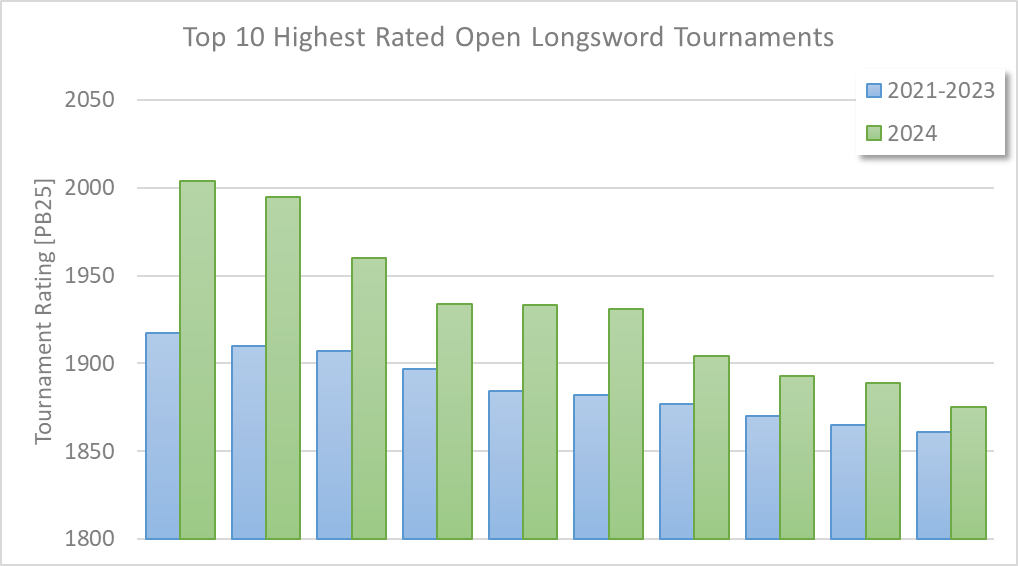
To put it in perspective, there were six tournaments in 2024 that exceeded the highest level tournament in the 2021-2023 period. Which is incredible.
But How Big Is Big?
So 2024 was a kick-ass year in Open Longsword competition compared to the other post-Covid years. But how does it stack up in terms of real competition? How does 2024 stack up to the pre-Covid golden age of high power HEMA tournaments? It turns out, it stacks up very well.
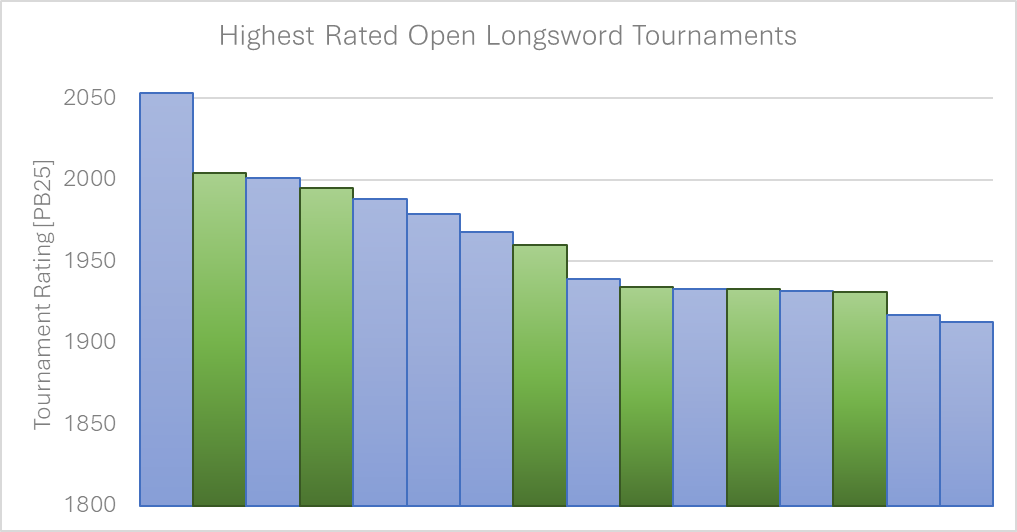
You read this correctly, over a third of the top 16 longsword tournaments of all time happened in 2024. If you are considering the number of high level events, 2024 is definitively the best year we have ever had. The only asterisk being we still haven’t had (at the time of this writing) an event to surpass the Minsk European Games in 2019. Which is a fantastic recovery, and a pretty clear indication that HEMA is back stronger than ever.
Women’s Longsword
I had intended to publish a follow up to my original article last year deep diving things other than Open Longsword. Which never happened. But while these stories are something that should be told, there is something crazy happening in Women’s longsword that I think is too cool not to mention right away.
There are several categories which have replaced traditional “women’s” tournament designations in a large number of events. The following analysis includes tournaments which are labeled as: Women’s, Women’s+, URG, MG, WNBT. While the differences between these are very important at a personal level to the individuals who participate, at the statistical level they all have a largely similar shared population. Enough so that they can be considered the same for this level of analysis.
While the number of high level open longsword tournaments that happened in 2024 is impressive, the number of high level women’s longsword tournaments that happened in 2024 is staggering.
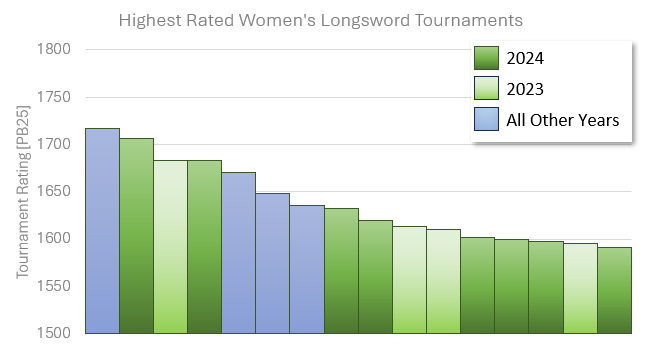
That’s right, the last two years make up 75% of the most competitive women’s tournaments! There is a lot to dig into here, a whole article’s worth in fact. So while that is a story for another day, I hope I’ve left you with a strong impression how much the women’s tournament scene is exploding.
Where Do We Go From Here?
Is 2024 a blip on the screen, or do we still go up from here? While we can only speculate, based on tournament entries to big events it seems like 2025 is destined to surpass previous heights. But as to if the volume of tournaments at high level continues to increase at the same pace, only time will tell.

